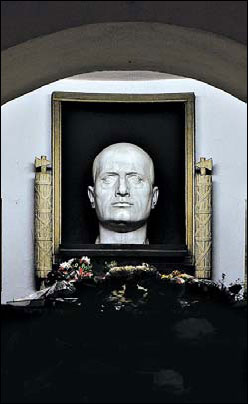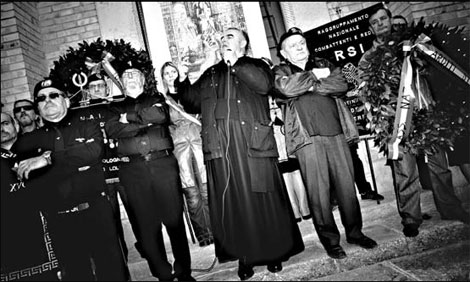A dead dictator still inspires in Italy
Updated: 2011-11-13 06:59
By Elisabetta Povoledo(The New York Times)
|
|||||||
Predappio journal
PREDAPPIO, Italy - "We come to thank this man for the most European, most Mediterranean, most original of ideas," said Father Giulio Tam, a familiar figure in right-wing circles, before he began reciting the rosary.
So it goes in Predappio, three times a year, to commemorate the day of Benito Mussolini's birth (on July 29, 1883, in a house not far from the cemetery), his death (at the hands of partisans on April, 28, 1945) and the so-called March on Rome, which brought Mussolini's party to power in Italy in October 1922.
They came last month in busloads, from Turin to Palermo, on a pilgrimage of sorts to the tomb of the former Fascist dictator. The tomb gets between 80,000 and 100,000 visitors a year
|
A view of Mussolini's crypt, in Predappio, which gets 80,000 to 100,000 visitors a year. Filippo Massellani for The New York Times |
"Like Christians going to St. Peter's, except that here some wear a fez," said Gianni, a man from Turin, of the black felt hat in the shape of a truncated cone that became part of the uniform of the Fascist black shirts worn here by a handful of meticulously groomed young men.
Others came to signify an epoch in which they believe that Italy, in contrast to today, counted for something in the world. "Italy needs a distinct change, we're in the hands of politicians who are unworthy to have been voted," said Enrico Cozzani, the owner of a security firm in Lucca. "We're the laughingstock of Europe."
After Mussolini was killed, a decision was made to obscure his grave site to avoid creating a shrine for their supporters.
Mussolini's corpse was hung up on meat hooks on April 29, 1945, in Milan, and he was buried in an unmarked grave in a nearby cemetery. A year later, neo-Fascist loyalists dug up his body and hid it in a convent in Lombardy until 1957, when the remains were returned to Mussolini's widow, who buried them in the family crypt in Predappio.
In fact, Italian authorities' efforts to hide the burial site backfired on them, as its location rapidly became a matter of intense interest. "A corpse that is nowhere is everywhere," said Sergio Luzzatto, a historian at the University of Turin who wrote "The Body of Il Duce," about the corpse's vicissitudes.
The museum of Duce memorabilia was opened in 2001 by Domenico Morosini, a Lombardy businessman, in what was once a Mussolini summer home.
The museum gets between 2,000 and 3,000 people a year and might attract more, but Mr. Morosini has found it hard to advertise. Road signs to the museum "constantly get knocked down by left-wingers," he said.
Predappio's center-left mayor, Giorgio Frassineti, would rather avoid this tourism.
"We refuse a vision of Predappio of the few, of the people who attend the commemorations, but also of those from the extreme left who want to cancel its history," Mr. Frassineti said. "These people just keep another kind of tourism at large."
The New York Times
|
Right-wing radicals, including Father Giulio Tam, center, a priest with a splinter sect, honor the tomb of Benito Mussolini. Filippo Massellani for The New York Times |
(China Daily 11/13/2011 page9)

